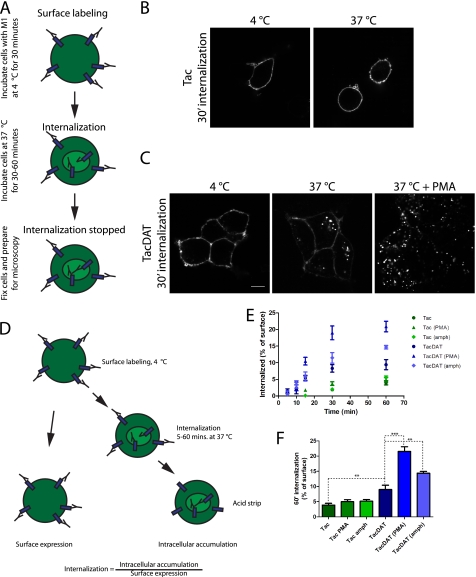FIGURE 2.
Visualizing and quantifying TacDAT internalization using M1 antibody-based internalization assays. A, to detect TacDAT internalization, we established a conventional antibody internalization assay in which we first labeled the cells with M1 antibody at 4 °C to label surface TacDAT at a temperature that blocked trafficking. Next, the cells were incubated at 37 °C in new medium for 30–60 min to allow internalization of TacDAT. For surface detection alone, the cells were kept at 4 °C. Subsequently, cells were fixed, permeabilized, and incubated with secondary fluorophore-conjugated antibody. The fluorescence was visualized using confocal microscopy. B, confocal images of HEK293 cells expressing Tac assayed as just described. C, the same assay with HEK293 cells expressing TacDAT. During the 30-min incubation at 37 °C, cells were incubated with or without the PKC activator PMA (1 μm). The images are representative of at least three similar experiments. D, brief description of ELISA-based internalization assay. As for the conventional microscopy-based internalization assay described above, cells were first labeled with M1 at 4 °C and then either incubated at 4 °C for surface detection or incubated at 37 °C for various periods to allow internalization. After the internalization period, the cells were placed on ice, and the surface antibody was stripped off using an acid strip buffer. After fixation, the cells were permeabilized, and the intracellular accumulated antibody was detected with a horseradish peroxidase-conjugated secondary antibody. The internalization signal was expressed as the proportion of the start surface signal. E, intracellular accumulation assessed by ELISA (as just described) in HEK293 cells transiently expressing TacDAT or Tac. Internalization was performed without or with PMA (1 μm) or amphetamine (10 μm) for the indicated times. Values are means ± S.E. of n = 6. F, intracellular accumulation after 60 min of internalization (means ± S.E. of n = 6; **, p < 0.01; ***, p < 0.001; one-way ANOVA with Bonferroni's multiple comparison test). amph, amphetamine; ′, minutes.

